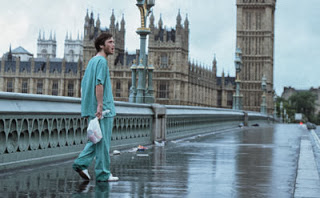Animal activists invade a laboratory with the intention of releasing chimpanzees that are undergoing experimentation, infected by a virus -a virus that causes rage. 28 Days Later, our protagonist, Jim, wakes up from a coma, alone, in an abandoned hospital. He begins to seek out anyone else to find London is deserted, apparently without a living soul. Selena and Mark rescue him from the horde and bring him up to date on the mass carnage and horror as all of London tore itself apart.
28 Weeks Later picks up six months after the Rage Virus has decimated the city of London. The US Army has restored order and is repopulating the quarantined city, when a carrier of the Rage Virus enters London and unknowingly re-ignites the spread of the deadly infection and the nightmare begins... again.
The 28 "" later franchise is a perfect example of films that possesses all the qualities and conventions of the post-apocalyptic genre.
However, unlike the previous films that put quite alot of focus on each shot, 28 days later was filmed with small, cheap cameras and scatters about the sets so that match on action could be accomplished on a larger scale, and the changing camera angles added more action and horror. You don't know where to look because the zombies, the heroes and creatures are continually moving at a fast pace like Danny Boyle himself had taken a shot of the Rage Virus.
In the first film, colours pop throughout the drab environmnet (For example: Jim's blue hospital gown in the empty city or Selena's red dress in the dusty old house.)
Due to separate film makers in the second film, more focus is put on the quality of the shots (For example: The boy staring through the glass to give off his reflection/A rifle scope showing a girl in the window), but there's less suspense in the sequel. This is due to the fact that you expect what's coming, and there is less attention on the jumpy camera angles that frighten the audience - gore is key in 28 weeks later.
Due to separate film makers in the second film, more focus is put on the quality of the shots (For example: The boy staring through the glass to give off his reflection/A rifle scope showing a girl in the window), but there's less suspense in the sequel. This is due to the fact that you expect what's coming, and there is less attention on the jumpy camera angles that frighten the audience - gore is key in 28 weeks later.
John Murphy's In the House, In A Heartbeat is a score written of 28 Days later's soundtrack. It is one of the most iconic instrumental songs in film making and the horror genre due to its gradual build-up of sombre instruments that conjeal into a mass of whirring guitars, heavy drums and coincide perfect with the film's themes of rage, human nature and shocking horror.
 |
| The blue of Jim's scrubs stands out in the vast, empty city. Everything in this shot is out of place, even the carrier bag. |



No comments:
Post a Comment